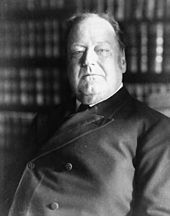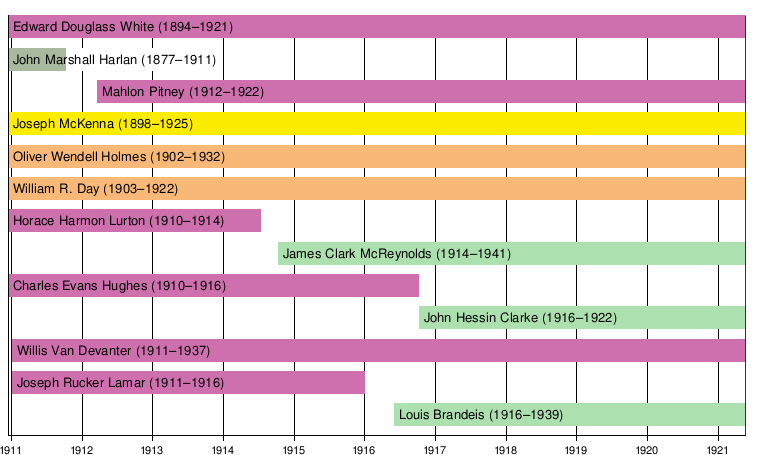
Charles Evans Hughes Sr. was an American statesman, politician, academic, and jurist who served as the 11th chief justice of the United States from 1930 to 1941. A member of the Republican Party, he previously was the 36th governor of New York (1907–1910), an associate justice of the Supreme Court (1910–1916), and 44th U.S. secretary of state (1921–1925). As the Republican nominee in the 1916 presidential election, he lost narrowly to Woodrow Wilson. Had Hughes won, he would have become the only former Supreme Court justice to be elected president.
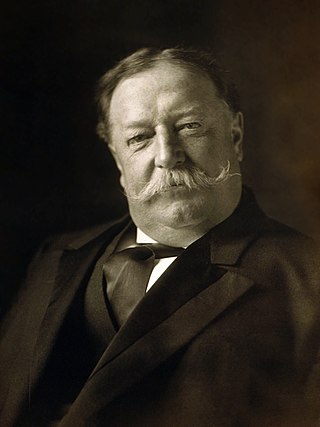
William Howard Taft was an American politician and lawyer who was the 27th president of the United States (1909–1913) and the tenth chief justice of the United States (1921–1930), the only person to have held both offices. Taft was elected president in 1908, the chosen successor of Theodore Roosevelt, but was defeated for reelection in 1912 by Woodrow Wilson after Roosevelt split the Republican vote by running as a third-party candidate. In 1921, President Warren G. Harding appointed Taft to be chief justice, a position he held until a month before his death.

Edward Douglass White Jr. was an American politician and jurist. White, a native of Louisiana, was a U.S. Supreme Court justice for 27 years, first as an associate justice from 1894 to 1910, then as the ninth chief justice from 1910 until his death in 1921. White is known for siding with the Supreme Court majority in Plessy v. Ferguson, which upheld the legality of state segregation.
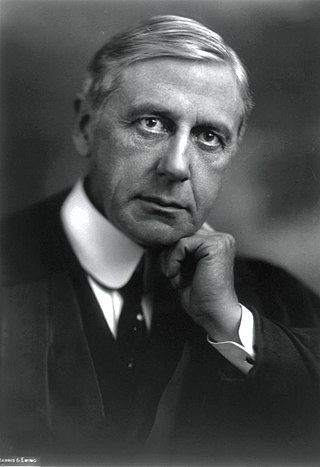
Mahlon R. Pitney IV was an American lawyer, jurist, and politician who served in the U.S. House of Representatives for two terms from 1895 to 1899. He later served as an associate justice of the U.S. Supreme Court from 1912 to 1922.
Missouri v. Holland, 252 U.S. 416 (1920) is a United States Supreme Court case concerning the extent to which international legal obligations are incorporated into federal law under the United States Constitution.

The Roberts Court is the time since 2005 during which the Supreme Court of the United States has been led by John Roberts as Chief Justice. Roberts succeeded William Rehnquist as Chief Justice after the latter's death.

The Rehnquist Court was the period in the history of the Supreme Court of the United States during which William Rehnquist served as Chief Justice. Rehnquist succeeded Warren Burger as Chief Justice after the latter's retirement, and Rehnquist held this position until his death in 2005, at which point John Roberts was nominated and confirmed as Rehnquist's replacement. The Rehnquist Court is generally considered to be more conservative than the preceding Burger Court, but not as conservative as the succeeding Roberts Court. According to Jeffrey Rosen, Rehnquist combined an amiable nature with great organizational skill, and he "led a Court that put the brakes on some of the excesses of the Earl Warren era while keeping pace with the sentiments of a majority of the country."
Newberry v. United States, 256 U.S. 232 (1921), is a decision by the United States Supreme Court which held that the United States Constitution did not grant the United States Congress the authority to regulate political party primaries or nomination processes. The court struck down 1911 amendments to the Federal Corrupt Practices Act which placed spending limits on candidate and political election committee spending in primaries or other nomination processes for federal office.
Weems v. United States, 217 U.S. 349 (1910), was a decision of the United States Supreme Court. It is primarily notable as it pertains to the prohibition of cruel and unusual punishment. It is cited concerning the political and legal relationship between the United States and the Philippines, which at that time was considered a U.S. colony.

The Marshall Court refers to the Supreme Court of the United States from 1801 to 1835, when John Marshall served as the fourth Chief Justice of the United States. Marshall served as Chief Justice until his death, at which point Roger Taney took office. The Marshall Court played a major role in increasing the power of the judicial branch, as well as the power of the national government.

The Burger Court was the period in the history of the Supreme Court of the United States from 1969 to 1986, when Warren Burger served as Chief Justice of the United States. Burger succeeded Earl Warren as Chief Justice after the latter's retirement, and served as Chief Justice until his retirement, at which point William Rehnquist was nominated and confirmed as Burger's replacement. The Burger Court is generally considered to be the last liberal court to date. It has been described as a "transitional" court, due to its transition from having the liberal rulings of the Warren Court to the conservative rulings of the Rehnquist Court.
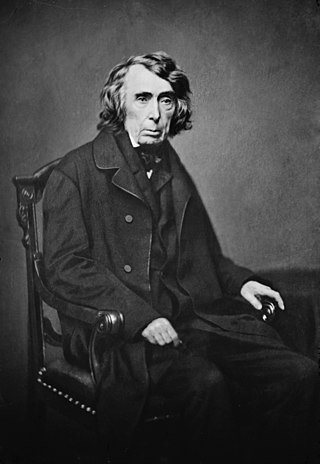
The Taney Court refers to the Supreme Court of the United States from 1836 to 1864, when Roger Taney served as the fifth Chief Justice of the United States. Taney succeeded John Marshall as Chief Justice after Marshall's death in 1835. Taney served as Chief Justice until his death in 1864, at which point Salmon P. Chase took office. Taney had been an important member of Andrew Jackson's administration, an advocate of Jacksonian democracy, and had played a major role in the Bank War, during which Taney wrote a memo questioning the Supreme Court's power of judicial review. However, the Taney Court did not strongly break from the decisions and precedents of the Marshall Court, as it continued to uphold a strong federal government with an independent judiciary. Most of the Taney Court's holdings are overshadowed by the decision in Dred Scott v. Sandford, in which the court ruled that African-Americans could not be citizens. However, the Taney Court's decisions regarding economic issues and separation of powers set important precedents, and the Taney Court has been lauded for its ability to adapt regulatory law to a country undergoing remarkable technological and economic progress.

The Chase Court refers to the Supreme Court of the United States from 1864 to 1873, when Salmon P. Chase served as the sixth Chief Justice of the United States. Chase succeeded Roger Taney as Chief Justice after the latter's death. Appointed by President Abraham Lincoln, Chase served as Chief Justice until his death, at which point Morrison Waite was nominated and confirmed as his successor.

The Waite Court refers to the Supreme Court of the United States from 1874 to 1888, when Morrison Waite served as the seventh Chief Justice of the United States. Waite succeeded Salmon P. Chase as Chief Justice after the latter's death. Waite served as Chief Justice until his death, at which point Melville Fuller was nominated and confirmed as Waite's successor.

The Hughes Court refers to the Supreme Court of the United States from 1930 to 1941, when Charles Evans Hughes served as Chief Justice of the United States. Hughes succeeded William Howard Taft as Chief Justice after the latter's retirement, and Hughes served as Chief Justice until his retirement, at which point Harlan Stone was nominated and confirmed as Hughes's replacement. The Supreme Court moved from its former quarters at the United States Capitol to the newly constructed Supreme Court Building during Hughes's chief-justiceship.

The Stone Court refers to the Supreme Court of the United States from 1941 to 1946, when Harlan F. Stone served as Chief Justice of the United States. Stone succeeded the retiring Charles Evans Hughes in 1941, and served as Chief Justice until his death, at which point Fred Vinson was nominated and confirmed as Stone's replacement. He was the fourth chief justice to have previously served as an associate justice and the second to have done so without a break in tenure. Presiding over the country during World War II, the Stone Court delivered several important war-time rulings, such as in Ex parte Quirin, where it upheld the President's power to try Nazi saboteurs captured on American soil by military tribunals. It also supported the federal government's policy of relocating Japanese Americans into internment camps.

The Vinson Court refers to the Supreme Court of the United States from 1946 to 1953, when Fred M. Vinson served as Chief Justice of the United States. Vinson succeeded Harlan F. Stone as Chief Justice after the latter's death, and Vinson served as Chief Justice until his death, at which point Earl Warren was nominated and confirmed to succeed Vinson.

The Taft Court refers to the Supreme Court of the United States from 1921 to 1930, when William Howard Taft served as Chief Justice of the United States. Taft succeeded Edward Douglass White as Chief Justice after the latter's death, and Taft served as Chief Justice until his resignation, at which point Charles Evans Hughes was nominated and confirmed as Taft's replacement. Taft was also the nation's 27th president (1909–13); he is the only person to serve as both President of the United States and Chief Justice.

The Fuller Court refers to the Supreme Court of the United States from 1888 to 1910, when Melville Fuller served as the eighth Chief Justice of the United States. Fuller succeeded Morrison R. Waite as Chief Justice after the latter's death, and Fuller served as Chief Justice until his death, at which point Associate Justice Edward Douglass White was nominated and confirmed as Fuller's replacement.
